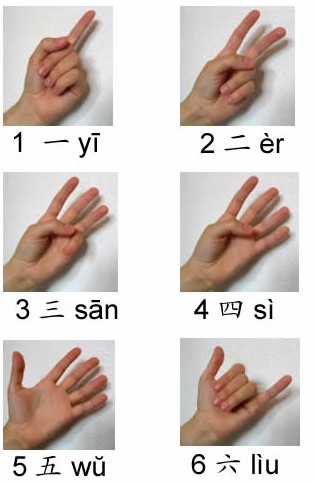Number gestures is various from all over the world. If you know Chinese number gestures, you can live better in China and communicate with Chinese. Chinese number gestures 汉字数字手势 refers to the Chinese method of using one hand to signify the natural numbers one through ten. This method may have been developed to bridge the many dialects in spoken Chinese– for example, the numbers 4 (Chinese: 四; pinyin: sì) and 10 (Chinese: 十; pinyin: shí) are hard to distinguish in some dialects. Some suggest that it was also used by businessmen during bargaining (i.e. to convey a bid by feeling the hand gesture in a sleeve) when they wish for more privacy in a public place.
Methods
While the five digits on one hand can easily express the numbers one through five, six through ten have special signs that can be used in commerce or day-to-day communication. The predominant [citation needed] system is as follows:
Six - The little finger and thumb are extended, other fingers closed, sometimes with the palm facing the signer.
Seven - The fingertips are all touching, pointed upwards; or just the fingertips of the thumb and first two fingers; a less common method is similar to the eight described immediately below, except that the little finger is also extended.
Eight - The thumb and index finger make an “L”, other fingers closed, with the palm facing the observer.
Nine - The index finger makes a hook, other fingers closed, sometimes with the palm facing the signer.
Ten - The fist is closed with the palm facing the signer; or the middle finger crosses an extended index finger, facing the observer.
Use of the signs corresponds to the use of numbers in the Chinese language. For instance, the sign for five just as easily means fifty. A two followed by a six, using a single hand only, could mean 260 or 2600 etc. besides twenty-six. These signs also commonly refer to days of the week, starting from Monday, as well as months of the year, whose names in Chinese are enumerations.
In Taiwan and Hong Kong
In Taiwan and Hong Kong, signs for numbers differ significantly from those described above. The symbol for 7 has an alternate meaning, and the symbol for 9 above, also described as such in Lonely Planet, actually means “death”. The signs used in Taiwan are as follow:
Six - As above, the little finger and thumb are extended.
Seven - The thumb and index finger make an “L” as in the symbol for eight above.
Eight - The thumb, index finger, and middle finger are extended.
Nine - Four digits excluding the little finger are extended. Since the little finger is not always independent of the ring finger, some might find this difficult to do. (In Hong Kong the gesture described above (with image below) is used instead.)
Ten - The index fingers of both hands are crossed in an “X” with the palms facing in opposite directions.
The numbers one through five are more trivial. For completeness:
One - The index finger is extended.
Two - The index and middle fingers are extended.
Three - With the index finger and thumb closed, the last three fingers are extended. Alternatively, the thumb holds the little finger in palm with the middle three fingers extended.
Four - The thumb is held in palm with the four fingers extended.
Five - All five digits are extended.


If you master Chinese number, you can learn more words about Chinese time below:
Months:
January: 一月 [yí yuè
February: 二月 [èr yuè]
March: 三月 [sān yuè]
April: 四月 [sì yuè]
May: 五月 [wŭ yuè]
June: 六月 [liù yuè]
July: 七月 [qī yuè]
August: 八月 [bā yuè]
September: 九月 [jiŭ yuè]
October: 十月 [shí yuè]
November: 十一月 [shí yī yuè]
December: 十二月 [shí èr yuè]
Weekdays:
Monday: 星期一 [xīng qī yī]
Tuesday: 星期二 [xīng qī èr]
Wednesday: 星期三 [xīng qī sān]
Thursday: 星期四 [xīng qī sì]
Friday: 星期五 [xīng qī wŭ]
Saturday: 星期六 [xīng qī liù]
Sunday: 星期日 [xīng qī rì]
 English
English Japanese
Japanese Korean
Korean French
French German
German Spanish
Spanish Italian
Italian Arab
Arab Portuguese
Portuguese Vietnamese
Vietnamese Russian
Russian Finnish
Finnish Thai
Thai dk
dk